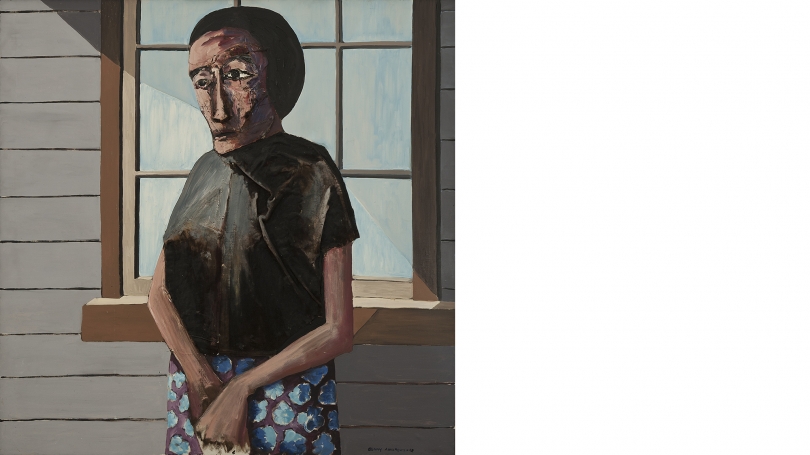Hood Quarterly, summer 2015
Juliette Bianco, Interim Director
Both depicting black life in America from a well of personal emotion and experience and advocating publicly for black artists, Benny Andrews (1930–2006) never distinguished art from education from activism. One of ten children in a Madison, Georgia, sharecropper family of African, Scottish, and Cherokee lineage, Andrews always identified as African American. After serving in the U.S. Air Force, he attended the School of the Art Institute of Chicago (1954–58), where he enjoyed access to the kinds of museums and libraries that had been closed to him in the segregated South. Andrews then moved to New York City, where he remained for most of his life. His work, in a variety of media, remained rooted in the human figure throughout his prolific career.
In 1968, returning to a technique that he had developed while in art school and then largely set aside during his early career, the artist completed Witness, one of several powerful collages that frame black Americans in the context of both defiance and survival. The painting's intensity arises from Andrews's incorporation of collaged elements, the composition's insistent focus on a single figure, and a title that can be taken as at once an observation and a command. He stated, "Black artists fought against an ingrained system that refused to allow them the one thing that practically everyone gives as the premise for individual artistic endeavors: the need to express oneself" (1). The subject in Witness is likewise a fighter. Though her resistance is subtle, she carries the gravitas of one who has survived the hardship of everyday life for a black American woman in the first half of the twentieth century. Andrews presents her against the backdrop of a simple exterior, which forces her to the front of the picture plane; the collaged sections of her face and clothing therefore appear to share the beholder's space with arresting immediacy. Her gaunt face and thin, ropy arms suggest someone who is elderly and worn. The rough cloth that defines her face and garments evokes the fabrics that Andrews recalls being dressed in as a child, including repurposed seed and fertilizer sacks, and contributes both authenticity and pride to her bearing. "I started working in collage," Andrews reported, "because I found oil paint so sophisticated and I didn't want to lose my sense of rawness. Where I am from, the people are very austere. We have big hands. We have ruddy faces. We wear rough fabrics. . . These are my textures."(2)
As the title Witness suggests, the painting serves as a testimony of a life defined by the defiance that derives from the power of seeing and surviving. The era in which Andrews painted Witness was marked more by his increased distance from the art market and visibility as an educator and activist in New York than by his actual output as an artist. In 1968, he began teaching at Queens College, and in 1969, he founded the Black Emergency Cultural Coalition (BECC), which organized protests against such institutions as the Metropolitan Museum of Art and the Whitney Museum of American Art for their non-representation of black artists, curators, and administrators. He was equally frustrated by the many labels assigned to black artists that separated their work from, rather than incorporated it into, the story of American art. Sharon Patton writes: "[Andrews] has fought being identified as a black artist, rather than an artist, and denied his right to be black. He dislikes classification of his art based on racial image, for his works then become an artistic 'other' with no relevance for mainstream America."(3)
When we presented Witness: Art and Civil Rights in the Sixties at the Hood Museum of Art in 2014, this painting was the signature work that introduced visitors to the exhibition's concepts, including the weight and responsibility for bearing witness to injustice, conflict, progress, and change, not always in equal measure. The powerful role of artists in this struggle became a touchstone for teaching with the exhibition, and during the run of the exhibition, faculty teaching twenty-one courses in twelve academic departments held their classes in the galleries and often began their discussions with Benny Andrews's Witness. These included courses with such titles as, "Black America since the Civil War," "Sex, Gender, and Society," "Democracy in America," "The African American Intellectual," "Identity and the Migrant Narrative," and "Human Rights, Global to Local." We are delighted to bring this work by one of the country's most important twentieth-century artists into the museum's collection, and to imagine that students enrolled in these classes, and many more, in the future will continue to benefit from its vision.
Notes
1. Mary Schmidt Campbell, Tradition and Conflict: Images of a Turbulent Decade, 1963–1973 (New York: Studio Museum in Harlem, 1985), 10.
2. Since the Harlem Renaissance: 50 Years of Afro-American Art (Lewisburg, Penn.: Center Gallery of Bucknell University, 1985), 10.
3. The Collages of Benny Andrews (New York: Studio Museum in Harlem, 1988), 8.
Related Exhibitions
- Witness: Art and Civil Rights in the Sixties
- Still We Rise: Women of Color Existence/Resistance in Contemporary Art
Related Stories
- Witness: Art and Civil Rights in the Sixties (Dartmouth Now)
- Community of Learners: Many Participate at the Hood Museum of Art
- Witness: Art and Civil Rights in the Sixties (Hood Quarterly)
- Alumni Voices: Dartmouth in the Civil Rights Era | Three Perspectives
- Alumni Voices: Crishuana Williams '12 | Florian Jenkins and The Life of Malcolm X (1972) at Dartmouth College
